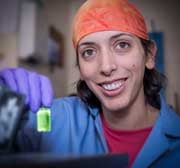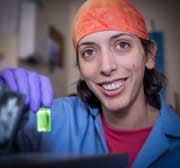 KINGSTON, R.I. – February 25, 2015 – In Mindy Levine’s world, chemical molecules are talkative little beings and she is trying to decipher how they communicate with each other when they are not attached. It’s research that can be applied to a variety of industries, from the development of tools for medical diagnostics to sensors for detecting toxicants in the environment.
KINGSTON, R.I. – February 25, 2015 – In Mindy Levine’s world, chemical molecules are talkative little beings and she is trying to decipher how they communicate with each other when they are not attached. It’s research that can be applied to a variety of industries, from the development of tools for medical diagnostics to sensors for detecting toxicants in the environment.
“If we can better understand the talking between molecules, we can use that knowledge to develop detection methods that are more sensitive and applicable in complex environments,” said Levine, assistant professor of chemistry at the University of Rhode Island.
Her research received a significant boost this month when she was awarded a $650,000 research grant from the National Science Foundation through its Faculty Early Career Development program, the most prestigious NSF grant program supporting junior faculty members. The grant will support her research into what she calls noncovalent interactions.
“I’m studying the way molecules are attracted to each other at distances that are close but not physically attached,” said Levine, a resident of Sharon, Mass. “These noncovalent interactions are responsible for how drugs act in the body and why electronic devices work so well.”
In her research, she will force different molecules close together to analyze how energy is transferred between them. She is particularly interested in energy transfer among toxic compounds because current technology requires those seeking to detect toxicants in the environment to know in advance what toxicant they are looking for.
“We’re hoping to develop sensors that are counterintuitively less sensitive for particular exact compounds and more generally sensitive for classes of compounds,” Levine said. “That will enable us to move away from requiring knowledge that is certainly not available in all situations. It’s outrageous to me that we need an offending company to be forthcoming about what they may have spilled in the environment in order for us to clean up that spill in a way that minimizes the negative health impact to nearby residents.”
She hopes her research will result in methods to quickly detect particular classes of compounds, “limiting the nonproductive guesswork and focusing instead on the compounds that you may have been exposed to,” she said.
In addition to funding her research, Levine’s grant will also support outreach activities designed to educate the public – especially high school girls – about chemistry and careers in science. For instance, she plans a “Sugar Science Day” in which 100 high school girls will spend a day at URI growing sugar crystals, measuring the sugar content of beverages and conducting other hands-on experiments with sugar. Two of the participating students will then receive a paid summer internship in her laboratory.
These activities are a follow-up to Levine’s annual chemistry camp, which she holds during April vacation week for middle school girls to increase their interest in science. This year’s camp, which runs April 20 to 24, features lipstick chromatography, the chemistry of bubbles, corn starch relays, and other chemistry activities using common household products.
“I want these girls to come out of this camp thinking that science is cool and that women can become scientists,” said Levine.
Photo by Michael Salerno Photography.

